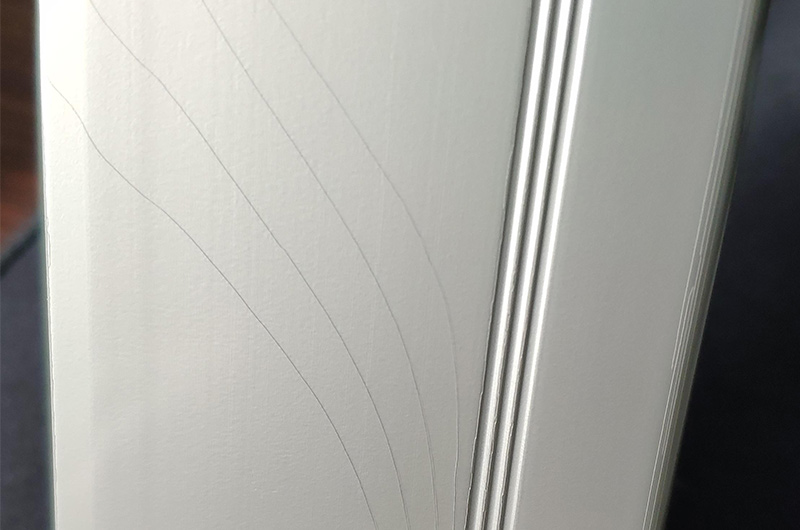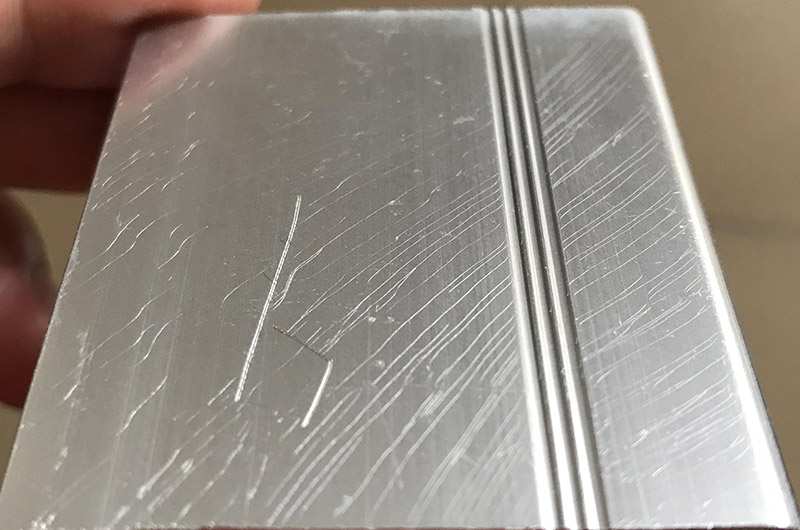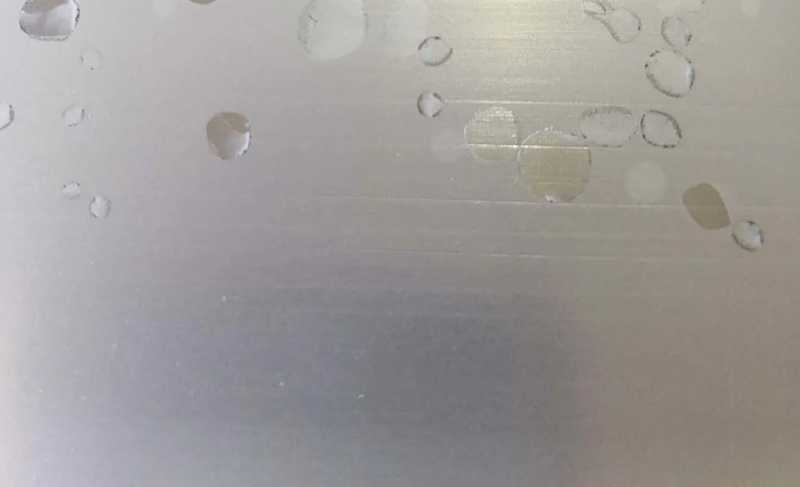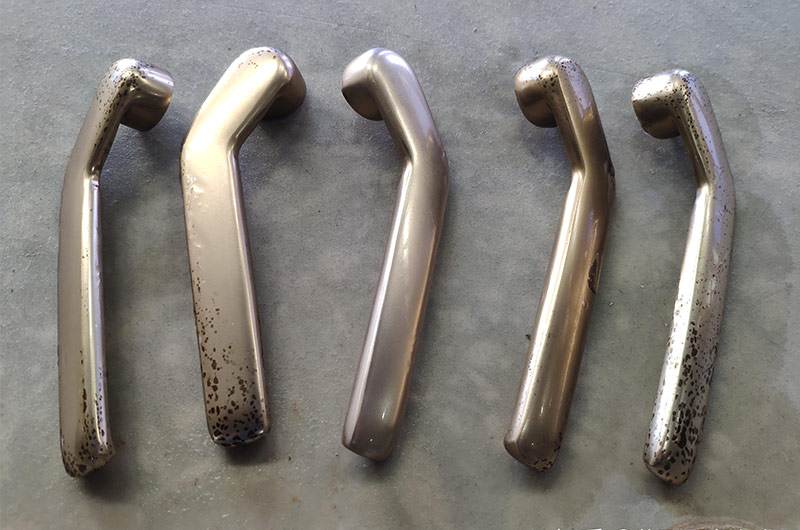Anodized Oxide Film Cracking and Peeling
Updated : Jan. 18, 2024During the production process, the anodized oxide film can experience cracking and peeling due to cutting, bending, and impact. Therefore, it is nearly impossible to completely avoid the occurrence of cracks and peeling in the anodized oxide film.
When considering the purpose and usage conditions of aluminum sheets, efforts should be made to minimize cracking and peeling, and prevent the formation of cracks that can cause significant harm.
By clearly understanding the respective causes of these issues, better solutions for relief and thorough resolution can be identified.
The occurrence and prevention of cracks in the anodized film of aluminum plates
Difference in linear expansion coefficient between aluminum plate and anodized film
The anodized oxide film on aluminum sheets has a linear expansion coefficient approximately 5 times larger than that of the aluminum sheet itself when subjected to heat.
When the aluminum sheet expands due to heating, the anodized oxide film, which grows in situ on the aluminum sheet, experiences strong tensile stress from the expanding aluminum, leading to separation.
The risk of thermal cracking increases with the hardness or thickness of the anodized oxide film. According to practical experience, a standard sulfuric acid anodized oxide film with a thickness of less than 8μm, after undergoing mid to high-temperature sealing without nickel, can withstand baking temperatures of up to 250°C without cracking. Beyond 8μm thickness, it becomes challenging to prevent baking-induced cracking.
Additionally, experiments have shown that better sealing results are associated with a higher likelihood of cracking.
Solutions include:Increase the linear expansion coefficient of the anodized oxide film. This involves improving the distribution of second phases in the alloy to prevent cracks from extending and moving along the interface between the anodized oxide film and the second phase.
Introduce a certain level of roughness to the aluminum surface. This induces localized microcracks in the anodized oxide film, releasing stress and reducing the occurrence of larger cracks.
Create an anodized oxide film with a higher porosity. This can be achieved by using alternating current anodization, employing an anodizing solution with high solubility, or adding specific chemicals to the oxidation bath. These measures alter the properties of the anodized oxide film pores (usually enlarging them and reducing the hardness of the oxide film), thereby reducing crack formation.
Utilize a radiating micropore structure in the anodized oxide film. Anodizing with chromic acid results in a more flexible oxide film with a significantly increased linear expansion coefficient, helping to avoid oxide film cracking to some extent.
Internal stress generated by oxide film during anodization process
Typically, during the growth of the anodized oxide film, there is a compressive stress within the oxide film due to the increase in volume, and there is a tendency to prevent cracking.
However, as the oxide film thickens and current density increases, the internal stress shifts towards tensile stress.
In some applications, producers of hard anodized coatings intentionally leverage this characteristic. They deliberately induce relatively uniform and widespread cracks during the anodizing process.
These cracks, when exposed to the subsequent operating environment, can absorb more lubricating grease, thereby reducing the wear of the anodized oxide film.

Solution: Control the internal stress of the anodized oxide film. It is more difficult for the anodized oxide film to crack when residual compressive stress is present.
To achieve this, reducing current density, increasing oxidation temperature, and minimizing oxidation time are advantageous for preventing the cracking of the anodized oxide film.
Anodic oxide film growth on protruding parts of aluminum plate
The anodized oxide film gradually expands during its growth process, allowing protruding parts of the aluminum sheet to form a complete oxide film.
However, if the curvature of the protruding part is too small (the protrusion is too sharp), when generating a thicker oxide film, the outward-expanding oxide film may not fully cover the aluminum surface, resulting in cracks from the surface to the aluminum substrate.
Solution: Round off sharp corners to create a larger curvature for the anodized oxide film.
Cracks caused by improper seal selection
For aluminum panels that will be exposed to prolonged outdoor sunlight, using a room temperature nickel-type sealer is obviously not suitable.
There are reports that fluoride nickel-type sealers are more prone to micro-cracking under intense sunlight or high-temperature exposure than boiling water sealing.
Therefore, it is advisable to avoid using cold sealing for aluminum panels in architectural applications.

Solution: The optimal sealing option for aluminum panels exposed to sunlight is high-temperature sealing without nickel, followed by nickel-type medium-to-high-temperature sealing and boiling water sealing.
Causes and prevention of oxide film peeling on aluminum plates
In general, the anodized film is a porous structure layer that grows in situ on the aluminum substrate.
The bonding strength between the oxide film and the substrate is much greater than that of common electroplating or spraying, making it unlikely for the oxide film to peel off from the substrate through mechanical external forces.
However, in reality, the peeling of the oxide film does occur, and the currently accepted theory attributes it to hydrogen.
Due to the overvoltage effect of hydrogen ions in the colored metal salt solution, during cathodic electrolysis, metal ions and hydrogen ions discharge simultaneously on the barrier layer at the bottom of the micropores.
The hydrogen gas generated at the bottom of the micropores hinders the supply of metal ions. Hydrogen ions (H+) discharging on the aluminum substrate produce hydrogen gas (H2) at the bottom, expanding its volume many times over.
There is no space for hydrogen gas to precipitate between the aluminum substrate and the barrier layer, disrupting the barrier layer.
The hydrogen gas then bulges outward in the opposite direction from the entrance, causing circular peeling of the anodized film and a cone-shaped destruction of the aluminum substrate. This phenomenon is known as peeling.

Effect of aluminum matrix alloy composition
In alloys with higher concentrations of Cu and Mg, a significant portion of Cu and Mg undergoes anodic dissolution.
Due to this dissolution, voids are formed, resulting in the formation of discontinuous anodized films. Therefore, alloys in the 2xxx series (containing copper) and 5xxx series (containing magnesium) are more prone to the peeling of anodized films.
Effect of thermal expansion of aluminum matrix
The presence of Mg and Zn in aluminum alloy elements will significantly increase the thermal expansion of the aluminum matrix, thereby increasing the risk of cracking and delamination of the anodized film.

Effects of power outage or interruption of oxidation
During the anodizing process of aluminum alloy, if a power outage or insufficient clamping at the hanging points occurs, resulting in an interruption of anodizing, chemical dissolution occurs between the substrate and the anodized film, creating gaps.
This leads to a reduction in the bond strength between the substrate and the anodized film, resulting in delamination of the anodized film.
The Influence of Residual Anodizing Solution in Micro Pores of Anodic Oxide Film Over Time
The porous structure of the anodic oxide film retains trace amounts of sulfuric acid. Under the influence of heat during processes like sealing and electrophoretic curing, a low-melting-point thin film alloy layer forms at the interface between the oxide film and the substrate.
These layers dissolve due to the formation of a local galvanic cell with the residual solution, creating voids, leading to a reduction in the adhesion of the anodic oxide film and resulting in delamination.
The impact of residual stress from mechanical processing before oxidation
After anodizing and dyeing, the oxide film of 2-series alloys tends to crack and peel during baking. The most probable reason for this is the stress generated on the surface of the material after machining.
After anodization, the stress amplifies the difference in thermal expansion between the oxide film and the substrate, ultimately leading to the peeling of the oxide film.

Certain companies faced a "paint-gate" controversy due to the extensive promotion of aluminum phone cases, where the peeling of paint was fundamentally attributed to the detachment of the oxide film.
Effect of electrolytic coloring of anodized film
The oxide film peeling that occurs during electrolytic coloring appears as spotted, mostly circular shapes with diameters ranging from 0.1mm to several millimeters. In most cases, these spots are not visually detectable until the oxide film is completely peeled off.
Additionally, compared to alternating current (AC) electrolytic coloring, direct current (DC) electrolytic coloring is more prone to peeling.
This is because, in cathodic electrolysis, the anodic oxide film undergoes hydrolysis, resulting in a neutral pH in the micro-pores and dehydration of the surface barrier layer due to electro-osmosis. Moreover, strong acidic tin salt electrolytic coloring is almost free from oxide film peeling compared to weak acidic nickel salt coloring.
Methods to prevent oxide film peeling
- Increase the conductivity of the coloring tank solution by adding appropriate conductive salts.
- Prevent and remove contamination in the coloring tank, such as harmful ions like Na+, K+, Al3+, NO3-, CrO2-, etc.
- Maintain the proper pH to ensure effective circulation of the tank solution during the coloring process.
- Adjust the ratio of cathodic and anodic reactions appropriately.
- If peeling occurs at the edges or raised areas of the workpiece, adjust to achieve a more uniform distribution of electrolytic current. This can be done through soft starting, stepwise voltage increase, or suitable current shielding measures.




